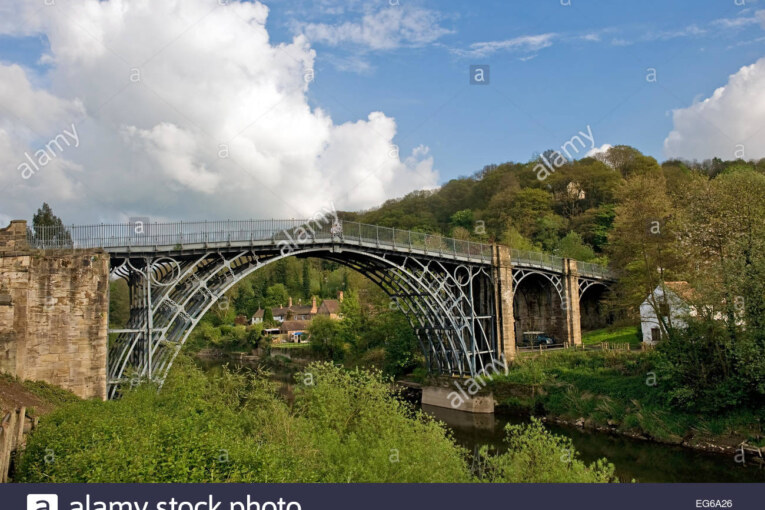
The Iron Bridge is a bridge that crosses the River Severn in Shropshire, England. Opened in 1781, it was the first major bridge in the world to be made of cast iron, and was greatly celebrated after construction owing to its use of the new material.
In 1934 it was designated a Scheduled Ancient Monument and closed to vehicular traffic. Tolls for pedestrians were collected until 1950, when ownership of the bridge was transferred to Shropshire County Council. It now belongs to Telford and Wrekin Borough Council. The bridge, the adjacent settlement of Iron bridge and the Ironbridge Gorge form the UNESCO Ironbridge Gorge World Heritage Site. The bridge is a Grade I listed building, and a waypoint on the South Telford Heritage Trail.
Construction
The site, adjacent to where a ferry had run between Madeley and Benthall, was chosen for its high approaches on each side and the relative solidity of the ground. The Act of Parliament described how the bridge was to be built from a point in Benthall parish near the house of Samuel Barnett to a point on the opposite shore near the house of Thomas Crumpton. Pritchard died on 21 December 1777 in his tower-house at Eyton on Severn, only a month after work had begun, having been ill for over a year.
The masonry and abutments were constructed between 1777 and 1778, and the ribs were lifted into place in the summer of 1779 by the use of wooden derricks and cranes. The bridge first spanned the river on 2 July 1779, and it was opened to traffic on 1 January 1781.
Design
The bridge is to a carpenters design typically used for wood structures, built from five, sectional, cast iron ribs that give a span of 100 feet 6 inches (30.63 m). Exactly 378 long tons 10 cwt (847,800 lb or 384.6 t) of iron was used in the construction of the bridge, and there are almost 1700 individual components, the heaviest weighing 5.5 long tons (5.6 t). Components were cast individually to fit with each other, rather than being of standard sizes, with discrepancies of up to several centimeters between ‘identical’ components in different locations.
Cast iron
Iron Bridge is made of cast iron, which is not a good structural material for handling tension or bending moments because of its brittleness and relatively low tensile strength compared to steel and wrought iron. In a few instances bridges and buildings built with cast iron failed. Cast iron has good compressive strengthand was successfully used for certain structural components in well designed old bridges and buildings. Puddled wrought iron, which was introduced after Iron Bridge was constructed, was a much better structural material. Puddled iron became widely available after 1800 and eventually became the preferred material for bridges, rails, ships and buildings until new steel making processes were developed in the late 19th century.
Cost
Darby had agreed to construct the bridge with a budget of £3,250 and £3,250 was raised by subscribers to the project, mostly from Broseley. While the actual cost of the bridge is unknown, contemporary records suggest it was as high as £6000, the excess being borne by Darby, who was highly indebted from other ventures as well. However, by the mid-1790s the bridge was highly profitable, and tolls were giving the shareholders an annual dividend of 8 per cent.
Restoration
After negotiations to raise the required funds, a programme of repairs took place on the foundations of the bridge at a cost of £147,000 between 1972 and 1975. The consulting engineers Sandford, Fawcett, Wilton and Bell elected to place a ferro-concrete inverted arch under the river to counter inward movement of the bridge abutments. Construction of the arch was carried out by the Tarmac Construction Company starting in the spring of 1973, but unusually high summer floods washed over the cofferdam, frustrating hopes that the work could be done in a single summer. Filling material was removed from the south abutment to reduce its weight, and the arch through it was reinforced with concrete. The road surface was replaced with a lighter macadam, the stone of the abutments was renewed and the toll-house was restored as an information centre. In 1980, the structure was painted for the first time in the 20th century, and the work was complete for the bicentenary of the opening, which was celebrated with a pig roast on 1 January 1981.
Construction Start: November 1777
Construction end: July 1779
Opened: 1 January 1781






